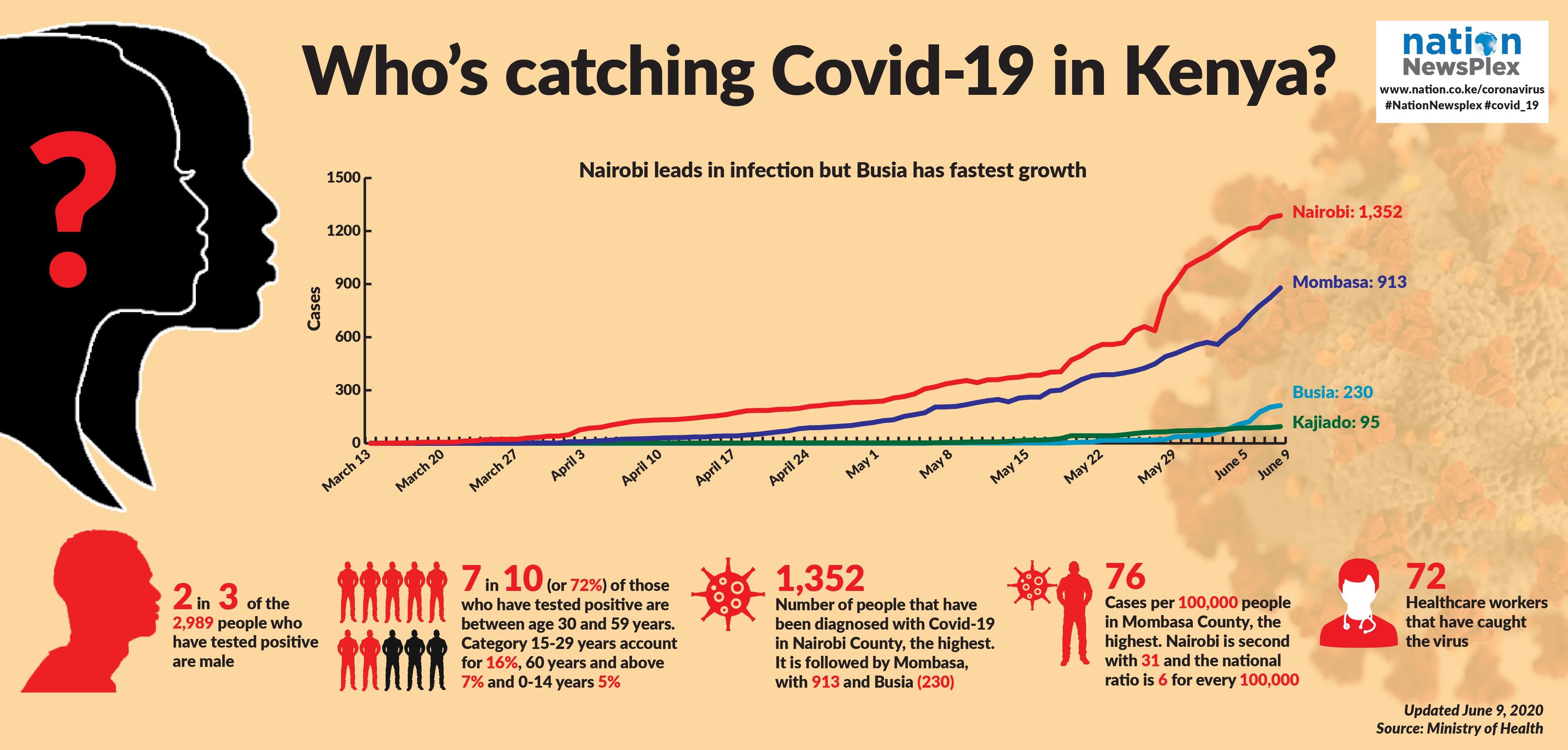Premium
Police killed 214 people as of October, database shows
Police killed more than 200 Kenyans by October 31, this year, numbers from the Nation NewsplexDeadly Force database show.
Nearly one in three of the 214, or 65 shootings, are related to election politics, while more than half, or 110 shootings, involved people suspected of crime, including shootouts.
Other deaths include officers killing their colleagues, and civilians after arguments or love disagreements. Two people have also been killed by non-police armed services, one by a Kenya Wildlife Service ranger, and another by a soldier in the Kenya Defence Forces.
Youth are particularly adversely affected by police shootings. Of the 56 people whose ages are known, 37 were aged between 18 and 35. Children have also not been spared as nine of those killed were under 18, and eight of whom were killed during election protests.
One was a six-month-old baby, Samantha Pendo, who died after being hit by police in Kisumu. Two children, Stephanie Moraa,10, and a boy aged seven, were killed while playing in Mathare as police dispersed protesters on August 8.
The following day a girl,15, was killed in Chesoi, Marakwet East, as police dispersed a crowd that was unhappy at delays in releasing the election results.
On August 11, Raphael Ayieko,17, was shot dead in Nairobi’s Baba Dogo as police dispersed protesters who were displeased with the election results.
On October 26, the day of the repeat presidential election, a 13-year-old boy was shot dead in Mavoko, while Titus Ngudi,14, was killed by stray bullet as police dispersed protesters.
Away from election protests, one boy aged 14 died after he was shot by a KDF soldier in Laikipia County on August 29. Still in the county, a 14-year-old boy was tortured to death by an Administration Police officer from Makutano Police Post on October, 31.
Five police officers have been killed by their colleagues so far. That is a significant decrease from 2016 when Deadly Force reported 18 police officers had been killed by colleagues over a similar time period.
The current shootings are a 52 per cent increase over the 141 shot in 2015 and a five per cent increase over the 204 people killed by the police last year. Of the 34 months Nation Newsplex has been tracking police killings, August 2017, the General Election month, had the highest number at 68.
The Deadly Force database compiled incidents from media reports in three daily newspapers, and reports from human rights organisations. The organisations have accused the police of using excessive force in dispersing protests.
Newsplex also sought to know from the National Police Service how many people had been killed in 2017. Police spokesman George Kinoti told Newsplex this information would be in the 2016/2017 crime statistics scheduled to be released at the end of the year
Outside political protests, police have also been faulted for killing people they suspect of crime, instead of arresting them and presenting them in court. Inclusion in the Deadly Force database does not necessarily mean a killing is unlawful.
In a joint report, Human Rights Watch and Amnesty International state that police killed at least 33 people in Nairobi after the General Election. More recently, Kenya National Commission on Human Rights (KNCHR ) says 54 people were killed in the election period between August and October. The Independent Medico-Legal Unit (IMLU) has also come forward, stating that 23 people died after the elections.
The National Police Service maintains only 19 people lost their lives around the two elections, and condemned the IMLU report as “sensational reporting that is based on falsified figures”. While the police does not name the people in its list, Human Rights Watch names the 33 people it claims were killed by officers in its report.
The police have also cited certain incidents where, they say, the use of force was necessary. For example, they have cited cases at Kit Mikayi Tallying Centre, Kisumu County, where a group of people had attempted to stop voting and Mavoko, Machakos County, where election officials were attacked, as well as in Homa Bay, where police used live bullets to stop a mob that tried to storm a patrol base.
However, the police in many instances were captured on video brutally beating unarmed civilians and destroying equipment such as motorcycles of boda boda operators. In one instance, police were captured firing low instead of high into the air exposing civilians to the risk of being struck by stray bullets.
Of the 214 people killed by police, 110 (51 per cent) were armed and 68 (32 per cent) were unarmed while it was not clear from reports whether 32 (15 per cent) were armed or not. However, there have been instances where police have been accused of planting guns on their victims.
In 95 per cent of the cases, (204 of 214) the victim died from gunshot wounds. Batons and tear gas are less lethal weapons used to disperse riots, but a number of deaths have been attributed to their use this year. In five cases, all of which happened during protests after August 8 elections, those who died had been beaten severely with batons.
Force their way
In two deaths, which took place in Mathare, Nairobi, the report by the KNCHR says police forced their way into the victims’ homes and beat them, leading to their deaths.
Also, on August 11, 2017, Henry Matete, 43, was coming home from hospital after having a wound dressed, when he met police officers at Bombolulu, Kibra, who beat him. According to the KNCHR, he died while receiving treatment in hospital.
Tear gas canisters have caused the deaths of another four people. Eric Kwama, who was suffering from a respiratory condition, died after inhaling the gas in Kawangware on August 10.
But three others died after tear gas canisters struck them in the chest area, exploding in some instances. All the deaths caused by tear gas canisters happened in Nairobi and were connected to protests after the presidential election of August 8.
Protests related to political events led to higher proportion of killings in certain counties, including Siaya, Kisumu and Nairobi.
Eight of the nine killings in Siaya County were related to politics. In addition to the police shooting in Yala, one shooting happened in February, during protests against the Independent Electoral and Boundaries Commission (IEBC).
Four killings took place in protests in the days after the August elections, while another three were killed on October 13 in protests around Bondo Police Station.
In Kisumu, six people have been killed. Four people were killed during election protests (three between August 11 and 12 and the fourth on October 16). Another two, who were suspected gangsters, were killed in Obunga area on June 17.
A total of 135 deaths – including five females – just over three in five deaths in 2017 so far, happened in Nairobi. Nineteen people were killed in Mathare, 15 in Kayole, 13 in Dandora, eight each in Kawangware and Karen, six each in Kibra and Pangani, four each in Baba Dogo and Kangundo Road, three each in Shauri Moyo, Parklands and Tena, and two each in Dagoretti, Eastleigh and Huruma.
Newsplex counted 48 people killed in the capital from protests after the elections, more than a third of all the people killed in the city. Another 82 were suspected of either planning or taking part in crime. Slightly more than half of all those shot in Nairobi (69) were reported to have been armed.
Gaza gang
While the names of crime suspects killed were rarely carried in media reports, the names of those killed in political disturbances tended to be available. Sixty-six crime suspects were male, and with the exception of three young men aged 18, 23 and 25, their ages were not reported.
The ages of 41 of the 135 people killed in Nairobi are known. Of those, 16 were aged between 20 and 29, nine between 30 and 34, and five between 40 and 45. Two men were older, one killed at 50 and the other 60.
In Machakos County, four people have been killed so far this year. Two were suspected criminals killed during robberies while two were killed during election protests in Mavoko.
All the nine people recorded killed in Kirinyaga County were suspected of crime. Seven of them were killed on September 5. Police said they had tracked them from Nairobi and that they were members of the notorious Gaza gang. Witnesses said they had defied police commands to surrender and opened fire before being killed. Another two suspects were killed at Kibwirigi Market during a robbery on September 20.
Six of seven people killed in Kiambu County were suspected criminals. The seventh was shot outside a bar in Limuru Town by a police officer. Five of the suspects were shot in Ruiru and the other in Karuri.
A police officer shot a woman on Nairobi’s Tom Mboya Street after she declined to marry him, before turning the gun onhimself. Mr Bunty Shah was shot in Westlands during an anti terror operation and police have admitted they made a mistake.
According to witnesses, Francis Karani was shot by police when he went to investigate a commotion on April 8, 2017, and had been in the process of buying a tank.
Christopher Maina was shot dead in Mathare’s Mlango Kubwa after he was picked up by police while he was working to erect pillars for a structure, according to the Mathare Social Justice Centre report.
In Mombasa, six of the seven people reportedly killed were suspected robbers while one was suspected of taking part in a terrorist attack in Mpeketoni that killed more than 60 people in June 2014.
For more on Deadly Force Database visit: https://nation.africa/kenya/newsplex/deadlyforce-311978




